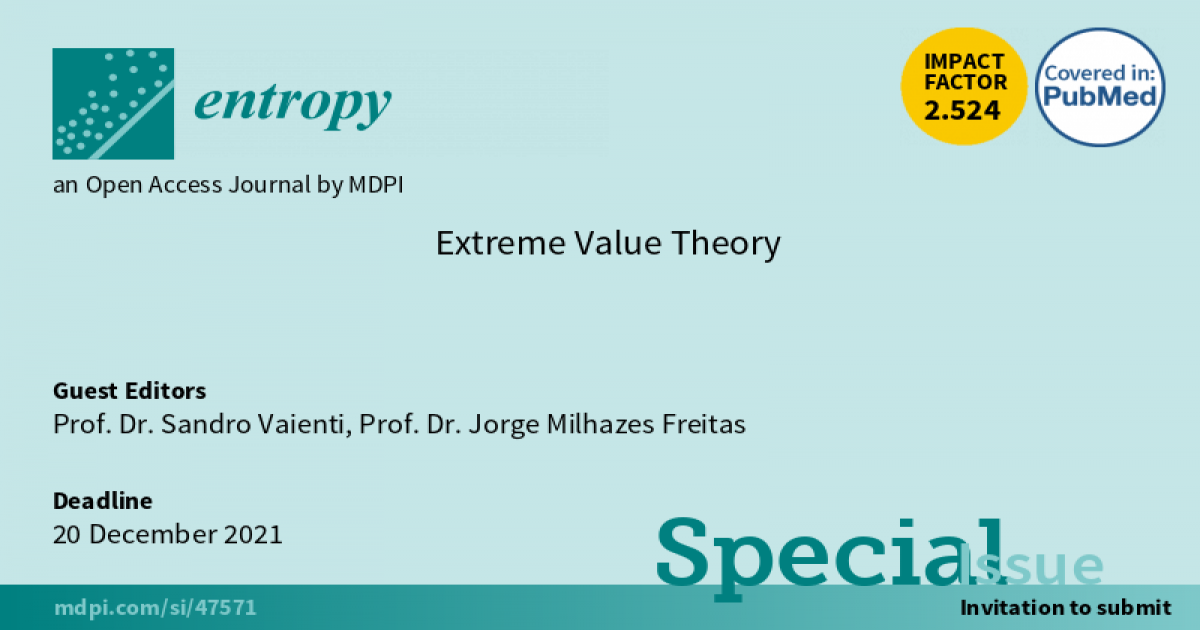Extreme Value Theory
A special issue of Entropy (ISSN 1099-4300). This special issue belongs to the section "Statistical Physics".
Deadline for manuscript submissions: closed (20 December 2021) | Viewed by 14101

Special Issue Editors
Interests: dynamical systems; limit theorems; random dynamical systems; extreme value theory and time series
Interests: statistical properties of dynamical systems; extreme value theory; recurrence and hitting times; limit theorems
Special Issues, Collections and Topics in MDPI journals
Special Issue Information
Dear colleagues,
Extreme value theory (EVT) has become a powerful tool in the last few years to analyze the statistical properties of dynamical systems, even under random perturbations. Its connection with quantitative recurrence properties of systems has propelled this subject to become an established area of interest. On the other hand, dynamical systems theory has enriched EVT by allowing it to obtain new and rigorous results, for instance, to study point processes, nonstationary systems, statistics of records, etc. These latter achievements have allowed new applications in different areas, such as physics, biology, and finance.
Prof. Sandro Vaienti
Dr. Jorge Milhazes Freitas
Guest Editors
Manuscript Submission Information
Manuscripts should be submitted online at www.mdpi.com by registering and logging in to this website. Once you are registered, click here to go to the submission form. Manuscripts can be submitted until the deadline. All submissions that pass pre-check are peer-reviewed. Accepted papers will be published continuously in the journal (as soon as accepted) and will be listed together on the special issue website. Research articles, review articles as well as short communications are invited. For planned papers, a title and short abstract (about 100 words) can be sent to the Editorial Office for announcement on this website.
Submitted manuscripts should not have been published previously, nor be under consideration for publication elsewhere (except conference proceedings papers). All manuscripts are thoroughly refereed through a single-blind peer-review process. A guide for authors and other relevant information for submission of manuscripts is available on the Instructions for Authors page. Entropy is an international peer-reviewed open access monthly journal published by MDPI.
Please visit the Instructions for Authors page before submitting a manuscript. The Article Processing Charge (APC) for publication in this open access journal is 2600 CHF (Swiss Francs). Submitted papers should be well formatted and use good English. Authors may use MDPI's English editing service prior to publication or during author revisions.
Keywords
- extreme events
- point processes
- recurrence
- clustering
- extremal index
- tail index
- dimension
Benefits of Publishing in a Special Issue
- Ease of navigation: Grouping papers by topic helps scholars navigate broad scope journals more efficiently.
- Greater discoverability: Special Issues support the reach and impact of scientific research. Articles in Special Issues are more discoverable and cited more frequently.
- Expansion of research network: Special Issues facilitate connections among authors, fostering scientific collaborations.
- External promotion: Articles in Special Issues are often promoted through the journal's social media, increasing their visibility.
- e-Book format: Special Issues with more than 10 articles can be published as dedicated e-books, ensuring wide and rapid dissemination.
Further information on MDPI's Special Issue policies can be found here.







